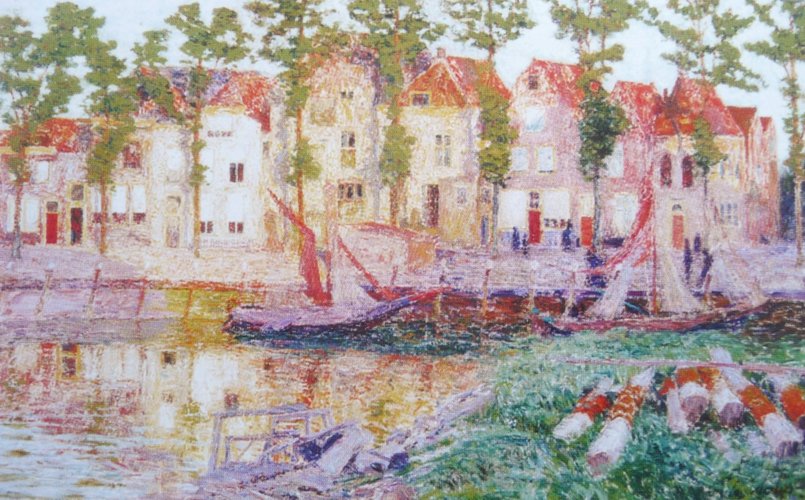Description:
Emile Claus (1849-1924) was a Belgian painter of origin. He attended a drawing course in Waeregem, studied at the Academy in Antwerp, which he left to pursue self-education. His creativity was influenced by a trip to Spain and Morocco in 1879, where he was impressed by the light phenomena. This affected the color palette he used. For years he exhibited his works in Europe. He is considered one of the most outstanding representatives of Belgian Impressionism and was a co-founder of the “Vie et Lumière” (“Life and Light”) group.
Description of the painting:
The painting shows a fragment of a small port town located on the Walcheren peninsula in the province of Zeeland. Claus came to this region looking for a fresh view and inspiration. The artist did not faithfully depict the port, focusing on the light impressions and, consequently, on the color. The painting belongs to a series of 6 paintings entitled by the artist “Facades encoillées”, or “Sunny Facades”, in which the artist observed the play of light on various buildings. The cycle also includes the painting “In the Shadow”, also found in the Rogalinska Gallery.
In the paintings of the Belgian Impressionist Emile Claus, the most important model is the sun. It plays the main role in his mature work, which, under the influence of a trip to Spain and Morocco, went from Impressionism to Lumism. Observed people, objects, buildings and landscapes play not so much a secondary role as an intermediary, servile one, because they reflect or absorb light in various, interesting ways for the painter. Inspired by French Impressionism, especially Monet’s work, the artist observed light impressions using daringly colored spots.
On the Rogalinska painting “Veere” we can see the frame of this small port town through the eyes of the artist. Located on the Walcheren peninsula in the province of Zeeland, it is now a tourist town, cut off from direct access to the sea since 1961. It is known for its picturesque and medieval character. Zeeland is still considered a Dutch province in which life is largely based on agriculture, fishing and tourism. At the turn of the 19th and 20th centuries, Claus came to this region looking for a fresh view and inspiration, just like the French artists in Brittany.
The tall, slender houses with red tiles are rhythmically intertwined with the tree trunks, passing like a decorative strip across the entire width of the painting. The houses stand in close frontage to the port, in which fishing boats are moored. The area of water became an opportunity to observe an interesting relationship between the blurred reflections on the surface of the reservoir and the light falling on both the buildings and the water. The foreground stands out with unnatural greens, contrasting with the red-white beams of wood left on the ground and the remains of a bridge or ship next to it.
Claus did not focus on a faithful, realistic representation of the view. The boats, buildings, trees and water, although recognizable, do not have clear contours and almost merge with each other. The distinction between the individual parts of the painting is possible due to different colors, but the whole is unified by a pinkish-blue color, which makes it difficult, while harmonizing the color composition. The painting is painted flat, in an almost naive convention, with bright colors, in which, in addition to the dominant green and red, there are violets, blues, yellows and whites. The painting seems to be a quick, impressionistic sketch, and in reality it is a study of light on the port façades. It belongs to a series of 6 paintings entitled by the artist “Facades encoillées”, or “Sunny Facades”, in which the artist observed the play of light on various buildings. The cycle also includes the painting “In the Shadow”, also found in the Rogalinska Gallery.


